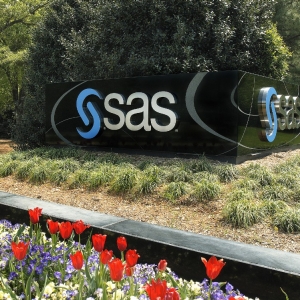Analytics vendor SAS announced Wednesday its SAS Analytics for IoT, a new package of proven software products that applies to the company’s core of analyzing massive amounts of data to IoT connected sensors and devices.
SAS Analytics for IoT helps organizations interpret rapidly moving and accumulating data, and confidently make decisions based on that data. The resulting gains — such as improved safety and reduced injuries or enhanced product quality — translate into healthier profits. The tool encompasses event stream processing along with visualization and analysis capabilities in a storage platform of choice. It supports analytics at the edge – as well as analysis, visualization and data integration on the server side (data center or cloud), and is applied to a range of IoT industries and needs.
With SAS Analytics for IoT, users can reduce cost and raise productivity by collecting, managing and analyzing data where it lives. SAS enables integration, visualization, transformation and analyses of IoT data across the ecosystem — edge devices, data centers or the cloud. It responds to changing conditions, and claim new IoT market opportunities to give users the ability to make better-informed business decisions. The offering also enables streamlining and automation of processes across the IoT infrastructure for incremental and long-term business gains.
From cars to factories to farms, many organizations are already collecting information from the connected devices that send and receive data over the Internet of Things. While analysts expect the IoT to soar to tens of billions of devices by 2020, no one knows how many or what new types of intelligent devices will emerge.

SAS combines streaming technology, analytics and domain expertise to turn IoT data into insight. Providing a secure path for predicting maintenance needs, personalizing offers on the spot, and triggering actions that deliver bottom-line business value, SAS helps organizations discover data that matters. SAS’ filtering focuses enterprises on what’s relevant and helps avoid the costly temptation of store everything. Organizations can mine and analyze IoT data throughout the connected ecosystem. Combining IoT data with other contextual data makes it easier to detect patterns of interest.
SAS Analytics for IoT injects powerful analysis into the data stream itself. Organizations base real-time action on signals as they occur, from simple alerts to complex automated responses.
SAS Analytics for IoT runs on a variety of platforms, including low-cost commodity hardware. It can exploit big data appliances and run in the cloud. SAS also works with many communication and hardware vendors to support embedded analytics in their edge devices, especially IoT gateways.
“To meet the needs of enterprises engaged in creating sensor data, it’s important to keep analytics front and center,” said Dan Vesset, IDC’s group vice president for analytics and information management. “Without predictive analytics at the edge and in the enterprise network, it will be difficult for any organization to realize the full potential represented by the IoT. That’s where SAS’ offering makes a lot of sense — whether the organization involved is engaged in manufacturing, energy, retail or any other industry that’s putting sensing devices into play.”
Companies using SAS to analyze IoT sensor data include Texas-based CPS Energy, who is building a flexible, sensor-dense power grid for San Antonio, and SAS analyzes its data all along the network – from the “edge” where the sensors generate the data to the database inside their network. By analyzing sensor data with SAS, Geneia-supported care teams can interpret contextual changes in a patient’s condition, intervene earlier and possibly prevent further deterioration.
A heavy truck, bus and military vehicle manufacturer, Navistar uses SAS to maximize its OnCommand Connection (OCC) system which monitors vehicles in real time. OCC sensors continuously stream multidimensional data from customers’ vehicles, including engine and fault codes. This capability allows Navistar to empathize with customers in ways that were impossible before.Town of Cary, N.C. Using SAS analytics to monitor data received from its Aquastar water-meter-infrastructure system, the Town of Cary has transformed its customer service model from reactive to proactive, resulting in earlier detection and communication of unusual customer water patterns.
Production engineers at data-storage manufacturer Western Digital use SAS to identify possible failures early in the production process, then make timely decisions to avoid quality issues.




